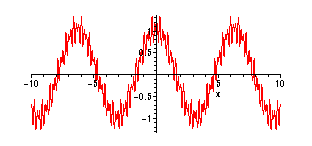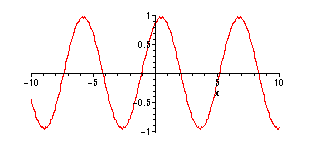![[Maple Math]](images/Avg1.gif) = ( f * B)(
x
), where B(
x
) = 1 on [0,1] and zero elsewhere.
= ( f * B)(
x
), where B(
x
) = 1 on [0,1] and zero elsewhere.
Mathematics 174 -- Applied Mathematics 2
The Averaging Filter
![[Maple Math]](images/Avg1.gif) = ( f * B)(
x
), where B(
x
) = 1 on [0,1] and zero elsewhere.
= ( f * B)(
x
), where B(
x
) = 1 on [0,1] and zero elsewhere.
For example, here are the graphs of an input signal and the output under the
averaging filter. Think of the input signal as
![]() , plus some higher
, plus some higher
frequency "noise":
> f:=x->cos(x)+15*cos(20*x)/100-cos(30*x)/5;
![]()
> plot(f(x),x=-10..10,numpoints=300);

> Gamma := (input,x) -> evalf(Int(input(s),s=x-1..x));
![[Maple Math]](images/Avg5.gif)
> plot(Gamma(f,x),x=-10..10,numpoints=300);

Note that the averaging seems to have largely "smoothed out" the noise and given something like
a horizontally shifted (and vertically scaled) version of the input. In fact, the magnitude
response function of the filter is given by
> plot(sqrt((2-2*cos(omega))/omega^2),omega=-6*Pi..6*Pi);

We do not have a sharp cut-off frequency here between the pass-band and the stop-band,
but this is also an example of a low-pass filter. And this one is causal, unlike the brick-wall
ideal low-pass filter. For examples like this one, the pass-band is taken (by definition or
convention) to be the interval of
![]() -values where the magnitude response is greater than
-values where the magnitude response is greater than
or equal to
![]() = .707 (approx). Here, that happens for
= .707 (approx). Here, that happens for
![]() in [
in [
![]() ,
,
![]() ]:
]:
> fsolve(sqrt((2-2*cos(omega))/omega^2)-1/sqrt(2),omega);
![]()
The value of the magnitude response at
![]()
> evalf(subs(omega=1,sqrt((2-2*cos(omega))/omega^2)));
![]()
gives the vertical scaling factor between the amplitude of the input and the amplitude of the
output.
>